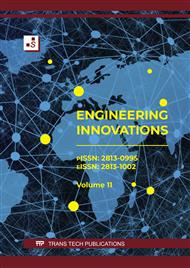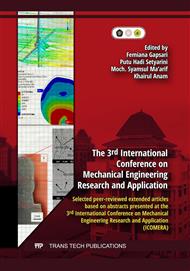[1]
M. A. Habib, A. U. Patwari, A. S. Anwar, S. Shadman, and O. H. Abir, "3D CFD Based Optimization Technique for Muffler Design of a Motorcycle," Appl. Mech. Mater., vol. 860, p.52–57, 2017.
DOI: 10.4028/www.scientific.net/AMM.860.52
Google Scholar
[2]
R. Li, Y. Zhou, Y. Xue, and S. Han, "Local Structural Optimization Method Based on Orthogonal Analysis for a Resistant Muffler," IEEE Access, vol. 9, p.40560–40569, 2021.
DOI: 10.1109/ACCESS.2021.3063768
Google Scholar
[3]
J. K. Lee, K. S. Oh, and J. W. Lee, "Methods for evaluating in-duct noise attenuation performance in a muffler design problem," J. Sound Vib., vol. 464, p.114982, 2020.
DOI: 10.1016/j.jsv.2019.114982
Google Scholar
[4]
A. Jahanbakhshi, M. Yousefi, S. Karami-Boozhani, K. Heidarbeigi, and Y. Abbaspour-Gilandeh, "The effect of combined resistance muffler on noise pollution and the allowable driver exposure in Massey-Ferguson tractors (MF 285 and MF 299)," J. Saudi Soc. Agric. Sci., vol. 19, no. 6, p.409–414, 2020.
DOI: 10.1016/j.jssas.2020.06.002
Google Scholar
[5]
M. Mohammadi and S. E. Razavi, "Investigation of the Efficiency of Various Reactive Mufflers by Noise Reduction and Transmission Loss Analyses," J. Theor. Appl. Vib. Acoust., vol. 4, no. 2, p.1–8, 2018.
Google Scholar
[6]
A. Kashikar, R. Suryawanshi, N. Sonone, R. Thorat, and S. Savant, "Development of muffler design and its validation," Appl. Acoust., vol. 180, p.108132, 2021.
DOI: 10.1016/j.apacoust.2021.108132
Google Scholar
[7]
S. Thirumurugaveerakumar, "Design and optimization of muffler back pressure," AIP Conf. Proc., vol. 2270, no. November, 2020.
DOI: 10.1063/5.0019700
Google Scholar
[8]
D. Siano, F. Bozza, and F. Auriemma, "Acoustic and fluid-dynamic optimization of an automotive muffler," Proc. Inst. Mech. Eng. Part D J. Automob. Eng., vol. 227, no. 5, p.735–747, 2013.
DOI: 10.1177/0954407012465689
Google Scholar
[9]
Y. C. Chang, M. C. Chiu, and M. R. Wu, "Acoustical assessment of automotive mufflers using FEM, neural networks, and a genetic algorithm," Arch. Acoust., vol. 43, no. 3, p.517–529, 2018.
DOI: 10.24425/123923
Google Scholar
[10]
S. Chao and H. Liang, "Comparison of various algorithms for improving acoustic attenuation performance and flow characteristic of reactive mufflers," Appl. Acoust., vol. 116, p.291–296, 2017.
DOI: 10.1016/j.apacoust.2016.09.034
Google Scholar
[11]
M. C. Chiu, "Genetic algorithm optimization on a venting system with three-chamber hybrid mufflers within a constrained back pressure and space," J. Vib. Acoust. Trans. ASME, vol. 134, no. 2, p.1–11, 2012.
DOI: 10.1115/1.4005220
Google Scholar
[12]
S. Zuo, K. Wei, and X. Wu, "Multi-objective optimization of a multi-chamber perforated muffler using an approximate model and genetic algorithm," Int. J. Acoust. Vib., vol. 21, no. 2, p.152–163, 2016.
DOI: 10.20855/ijav.2016.21.2405
Google Scholar
[13]
C. Lu, W. Chen, Z. Liu, S. Du, and Y. Zhu, "Pilot study on compact wideband micro-perforated muffler with a serial-parallel coupling mode," Appl. Acoust., vol. 148, p.141–150, 2019.
DOI: 10.1016/j.apacoust.2018.12.001
Google Scholar
[14]
Y. C. Chang, M. C. Chiu, and S. E. Huang, "Numerical analysis of circular straight mufflers equipped with three chambers at high-order-modes," Appl. Acoust., vol. 155, p.167–179, 2019.
DOI: 10.1016/j.apacoust.2019.05.021
Google Scholar
[15]
A. Elsayed, C. Bastien, S. Jones, J. Christensen, H. Medina, and H. Kassem, "Investigation of baffle configuration effect on the performance of exhaust mufflers," Case Stud. Therm. Eng., vol. 10, p.86–94, 2017.
DOI: 10.1016/j.csite.2017.03.006
Google Scholar
[16]
D. A. Bies, C. H. Hansen, and C. Q. Howard, Engineering Noise Control, Fifth edit. CRC Press Taylor & Francis Group, 2018. [Online]. Available: http://books.google.com.sg/books?id=LU8U3mka-DUC&pg=PA665&dq=loss+factor+for+materials+table&hl=en&sa=X&ei=dcSlT_mALJCurAfS6MTgAQ&redir_esc=y#v=onepage&q=loss factor for materials table&f=false%5Cnhttp://books.google.com.sg/books?id=LU8U3mka-DUC&pg=PA665&
Google Scholar



